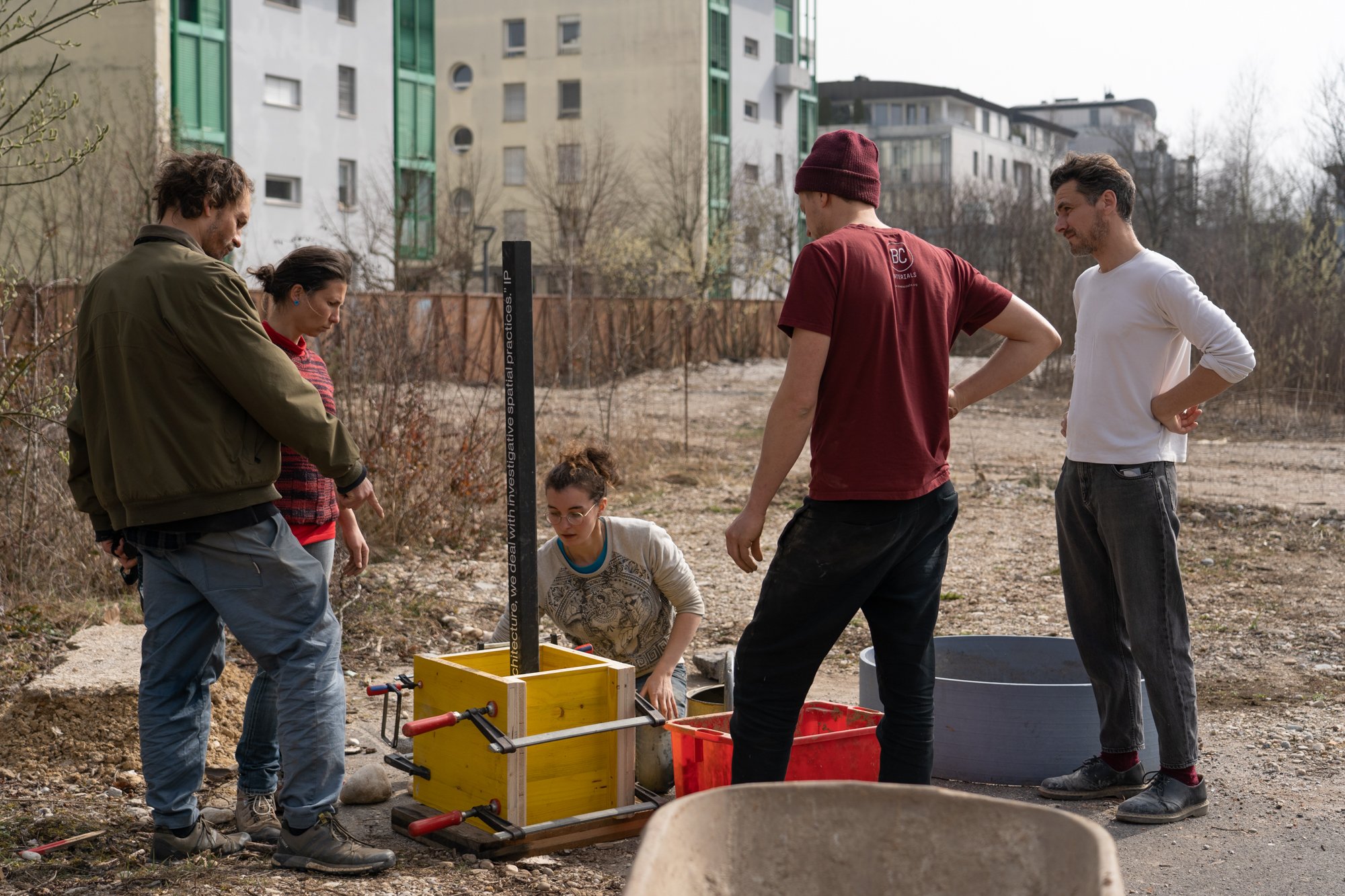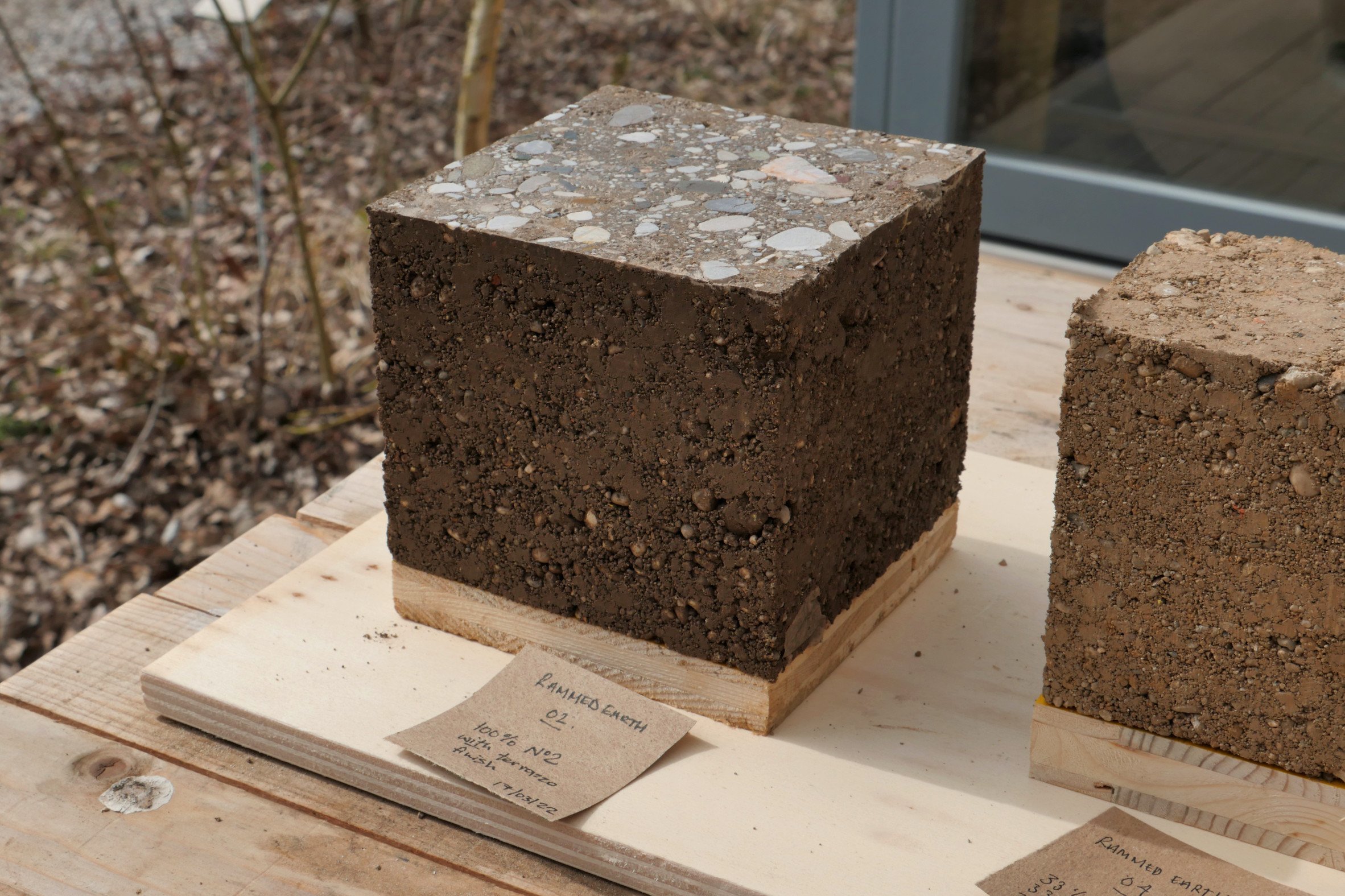Traditional Futures
BIO27: Super Vernaculars is the 2022 edition of Ljubljana’s design biennial (image: Urban Cerjak/MAO ).
There is a crater in the heart of Ljubljana. North of the Slovenian's capital’s almost-too-perfect Old Town, in a fairly anonymous patch of mid-rise housing, there is a massive hole in the ground. It was once occupied by a military barracks, which was demolished in the wake of Yugoslavia’s disintegration. In the years since, this wasteland has gone to seed. A remarkable variety of plants now occupy the pit and its surroundings, along with a legion of voracious mosquitos.
The area containing the crater has now become Krater, an “emerging production space for trans-disciplinary practices'' established in a collaboration between design, permaculture and plant experts. It provides space for artists, designers, biologists and ecologists who experiment in permaculture, sustainable materials and small-scale, eco-friendly production. One structure serves as a greenhouse for a local commune that creates veg boxes to sell locally. A pretty, blue-painted summer house hosts a houseplant adoption agency, where those who feel capable of looking after a plant can sign a contract to take one home. There is an education programme, a wood workshop and a goldfish pond. It would be idyllic if not for the bloodletting.
When I visit Krater in May, a table has been laid out with samples of sustainable paper made from, among other things, rammed earth, fungi, and Japanese knotweed – the most infamous of invasive species. By foraging this abundant pest and using it to make recyclable, biodegradable Notweed Paper, design collective Tranja aspires towards a truly regenerative process, whereby even the most disregarded of material can be given new life. Krater has no such new future: it will vanish in two years when a new Slovenian Ministry of Justice is built on top of it, destroying the rewilded ecosystem. Those who use it hope they will be able to continue elsewhere.
Krater is a rewilded wasteland serving as a sustainable design laboratory.
Krater is one of the projects featured in BIO27, the 2022 edition of Ljubljana’s longstanding design biennial BIO. This year's theme, Super Vernaculars: Design for a regenerative future, posits that traditional insights can be applied to find responses to climate catastrophe and resource loss. It draws on the present surge of interest in TEK, or Traditional Ecological Design. “These “ideas have been gaining in credence and influence in recent years,” explains biennial curator Jane Withers. "BIO27: Super Vernaculars is an opportune moment to collect and interrogate proposals for alternative ways of building, farming, making, eating, and living that are inspired by experiences and value systems from diverse cultures.”
BIO is Europe’s oldest design biennial (the Triennale di Milano is disqualified from running, for the obvious reason). The Biennale of Industrial Design (Bienale industrijski oblikovanja) was established in 1963 and was intended as both a showcase of Yugoslavian design and a place for local practitioners to keep abreast of international trends. Products were submitted by design associations in various countries then displayed in categories, which ran the gamut from the very general — Lamps, Furniture, Textiles — to the very specific, such as Optical Objects and Sports Equipment.
This arrangement survived until 2008, when BIO21 scrapped the national representation aspect. Two editions later, under the direction of Belgian curator Jan Boelen, it changed format completely, becoming a topical exhibition of design without national or generic classification. Throughout the past four editions, BIO has deftly repositioned itself as a thoughtful event entirely removed from the commercial interests that lurk in the shadows at many design exhibitions. It has also become something of a trend barometer: the 2017 edition, Faraway, So Close, looked at the ever-growing rural-urban divide several years before OMA’s Countryside: The Future at the Guggenheim.
Rammed earth is one of the natural materials explored at Krater.
Withers’ programme is serious and rigorous, not least when looking at itself. It comprises main exhibition and a series of Production Platforms, which feature young Slovenian designers mentored by established figures. Regenerative Cultural Production, by Žan Kobal, Tamara Lašič Jurković, Barbara Predan with guidance from Sophie Thomas, is one of these platforms and takes the form of an environmental audit of the biennale itself. So the team have, for instance, calculated the number of the trees that would have to be planted to offset the emissions of BIO26. Withers has strived to make BIO27 improve on past results. Aluminium furniture is out. The exhibition design is all made from borrowed firewood that will be returned to its owners after the show. The number of international designers invited has been slashed, to reduce flight emissions.
BIO27’s main exhibition occupies the Museum of Architecture and Design (MAO), an achingly picturesque fortified mansion on the city’s eastern edge. Withers’ show is both compact and abundant. It is structured like a thesis: we begin a review of the theoretical underpinnings and some historical precedents, before moving forward to the present day projects that develop Withers’ argument. Quotes from design and non-design figures are printed around the exhibition, creating the sense that a panoptic sweep of ideas have been incorporated.
Perhaps the presiding theoretical figure at the biennial is Bernard Rudofsky. His MoMA exhibition and book Architecture Without Architects (1964) presented indigenous buildings from around the world without explanatory text or context. Rudofsky both challenged modernist orthodoxies about architectural progress and the convention that good design comes from those accredited as designers. Enzo Mari is also brought in with his Autoprogettazione (1974), a manual for making one’s own wooden furniture. Its lurid colours and comb-binder form embody Withers’ insistence that traditional crafts are not mere historical relics but techniques that can be brought to bear throughout time.
A hat made of fungus dates from the 19th century.
Some spotlight is given to Slovenia’s own history of vernacular creations. A room-size installation by researcher Adam Štech places photographs of vernacular structures in Slovenia and Croatia alongside modernist interiors, as if to challenge the division. Elsewhere, there are some delightful historic exhibits, including a 19th-century waterproof hat made from a polypore bracket fungus, and a beehive carved out of a tree trunk. The former in particular proposes a link between today’s material experimentation and the environmental knowledge of the vernacular craftsperson. Another section looks at the hayrack, a structure that resembles a floating gable roof but is actually used to dry hay, grains and beans, which remain a characteristic feature of the Slovenian countryside today.
The subsequent sections of Super Vernaculars gather design, architectural and research projects that show traditional techniques reimagined for contemporary needs. A handful of the exhibits involve the creation of new materials – that benchmark of contemporary sustainable design. Among of the most impressive, Tranja’s Notweed paper aside, are Qwstion’s canvas-like Bananatex, made from plant fibres in the Philippines; Margent Farm’s corrugated hemp panels that resemble steel; and the sunflower-stem acoustic panels and rice-straw insulation blocks developed at Atelier LUMA in Arles.
Drawn from locally available material, these projects have a vernacular spirit, though they often require a degree of experimentation and processing that is difficult to access for those without expertise and the requisite experience. But BIO27 is keen to show that expertise can be found everywhere. The exhibition’s launch evening also served as a tasting ceremony for the Sausage of the Future (Slovenian edition), a strangely attractive green-coloured banger made from buckwheat, mushrooms, wild garlic, chives and parsley, available in both low-meat and no-meat forms. Both were pretty good, though I have to admit I prefer the traditional, probably far less sustainable Carniolan sausage that inspired it. But that is besides the point. The sausage was a collaboration between designer Carolien Niebling, chef Igor Jagodic and butcher Marko Butalič, a coming together of expertise from within and without the design world.
The exhibition’s temporary furniture is made out of firewood that’s on loan from its owners.
Another through-line focuses on things that people or communities can create themselves, with a little guidance. Sculptor Alicja Bielawska presents a photographic survey of the use of textile to heat or cool pre-modern Polish homes. Rok Oblak’s Holey Roket is an open-source design for a biomass stove. Social Design Collective’s ModSkool is a modular, low-cost school that can be assembled and disassembled, to be used by farming communities in Delhi facing periodic eviction. The walls and doors can be built using charpai, a local cot-weaving technique. And Eindhoven graduate Ruben Warnshuis’ Industrial Devolution is a footwear workshop where people can learn to create woven shoes with looms and moulds. They look fabulous, though I am curious to see how they hold up to the wear-and-tear of everyday use.
BIO27 abounds with such ingenuous, well-chosen projects. Many of them are not objects but guides to the making of objects, things aim to be taught, disseminated and adapted. The second edition of craft biennale Homo Faber, which ran this April in Venice, posited handicraft as a rarefied decorative field, where the best craftsmanship is that which only a handful of virtuosic can achieve. Super Vernaculars suggests that the best objects are those which can be implemented by anyone, to the greatest benefit for themselves and humanity.
Sausage of the Future is a collaboration between a designer and a chef.
There is a flip side. As with other exhibitions that argue that design can help bring us to a sustainable model of life, I found myself alternatively excited by the work on display and dispirited by the political, legal, cultural and economic realities that prevent such projects from taking flight. Take the mycelium panels developed at Krater by microbiologist Primož Turnšek. The American firm Ecovative Design has patented a similar substance, making it impossible for those who create mycelium insulation in their own labs to sell commercially. Trailblazing sites such as the zero-waste town Kamikatsu in southern Japan remain just that, one-off trailblazers.
Perhaps a return to localised modes of production can spare us the oncoming storm of climate catastrophe and a collapse in living standards. But that post-capitalist world seems very far away, and a daunting prospect for anyone who has grown used to the comforts enjoyed by those from the exploiting side of globalisation. Quietly but convincingly, Super Vernaculars calls for nothing less than a wholesale revolution.
Words Joe Lloyd
Photos Urban Cerjak/MAO
BIO27: Super Vernaculars runs in Ljubljana until 29 September 2022






